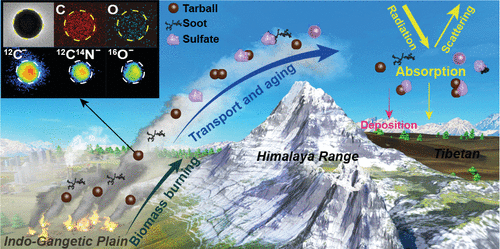当前位置:
X-MOL 学术
›
Environ. Sci. Technol. Lett.
›
论文详情
Our official English website, www.x-mol.net, welcomes your feedback! (Note: you will need to create a separate account there.)
Evidence for Large Amounts of Brown Carbonaceous Tarballs in the Himalayan Atmosphere
Environmental Science & Technology Letters ( IF 10.9 ) Pub Date : 2020-11-04 , DOI: 10.1021/acs.estlett.0c00735 Qi Yuan 1 , Jianzhong Xu 2 , Lei Liu 1 , Aoxing Zhang 3 , Yanmei Liu 2 , Jian Zhang 1 , Xin Wan 4 , Mengmeng Li 5 , Kai Qin 6 , Zhiyuan Cong 4 , Yuhang Wang 3 , Shichang Kang 2, 7 , Zongbo Shi 8 , Mihály Pósfai 9 , Weijun Li 1
Environmental Science & Technology Letters ( IF 10.9 ) Pub Date : 2020-11-04 , DOI: 10.1021/acs.estlett.0c00735 Qi Yuan 1 , Jianzhong Xu 2 , Lei Liu 1 , Aoxing Zhang 3 , Yanmei Liu 2 , Jian Zhang 1 , Xin Wan 4 , Mengmeng Li 5 , Kai Qin 6 , Zhiyuan Cong 4 , Yuhang Wang 3 , Shichang Kang 2, 7 , Zongbo Shi 8 , Mihály Pósfai 9 , Weijun Li 1
Affiliation

|
Primary brown carbon (BrC) co-emitted with black carbon (BC) from biomass burning is an important light-absorbing carbonaceous aerosol. BC from the Indo-Gangetic Plain can reach the Himalaya region and influence glacial melting and climatic change. However, to date, there is still not sufficient direct evidence for primary BrC in the Himalayan atmosphere. Here, we detected light-absorbing tarballs at microscopic scale collected on the northern slope of the Himalayas. We found that about 28% of thousands of individual particles were tarballs. The median sizes of externally mixed tarballs and internally mixed tarballs were 213 and 348 nm, respectively. Air mass trajectories, satellite detection, and Weather Research and Forecasting model coupled to Chemistry (WRF-Chem) simulations all indicated that these tarballs were emitted from biomass burning in the Indo-Gangetic Plain. A climate model simulation shows a significant heating effect (+0.01–4.06 W/m2) of the tarballs in the Himalayan atmosphere. We conclude that the tarballs from long-range transport can be an important factor in the climatic effect and would correspond to a substantial influence on glacial melting in the Himalaya region.
中文翻译:

喜马拉雅大气中大量棕色碳质油球的证据
生物质燃烧过程中与黑碳(BC)共同发射的初级棕碳(BrC)是一种重要的吸光碳质气溶胶。来自印度恒河平原的卑诗省可以到达喜马拉雅地区,并影响冰川融化和气候变化。但是,迄今为止,在喜马拉雅大气中仍没有足够的直接证据证明原BrC。在这里,我们检测到了喜马拉雅山北坡上收集到的微观尺度的吸光柏油。我们发现,成千上万的单个粒子中约有28%是压缩包。外部混合压缩包和内部混合压缩包的中值大小分别为213和348 nm。空气质量轨迹,卫星探测,与天气研究和预报模型相结合的化学(WRF-Chem)模拟都表明,这些tarball是由印度恒河平原生物质燃烧产生的。气候模型模拟显示了显着的热效应(+ 0.01–4.06 W / m2)在喜马拉雅大气中的压缩包。我们得出的结论是,远距离运输产生的柏油可能是影响气候的重要因素,并且将对喜马拉雅山地区冰川融化产生重大影响。
更新日期:2020-11-04
中文翻译:

喜马拉雅大气中大量棕色碳质油球的证据
生物质燃烧过程中与黑碳(BC)共同发射的初级棕碳(BrC)是一种重要的吸光碳质气溶胶。来自印度恒河平原的卑诗省可以到达喜马拉雅地区,并影响冰川融化和气候变化。但是,迄今为止,在喜马拉雅大气中仍没有足够的直接证据证明原BrC。在这里,我们检测到了喜马拉雅山北坡上收集到的微观尺度的吸光柏油。我们发现,成千上万的单个粒子中约有28%是压缩包。外部混合压缩包和内部混合压缩包的中值大小分别为213和348 nm。空气质量轨迹,卫星探测,与天气研究和预报模型相结合的化学(WRF-Chem)模拟都表明,这些tarball是由印度恒河平原生物质燃烧产生的。气候模型模拟显示了显着的热效应(+ 0.01–4.06 W / m2)在喜马拉雅大气中的压缩包。我们得出的结论是,远距离运输产生的柏油可能是影响气候的重要因素,并且将对喜马拉雅山地区冰川融化产生重大影响。



























 京公网安备 11010802027423号
京公网安备 11010802027423号